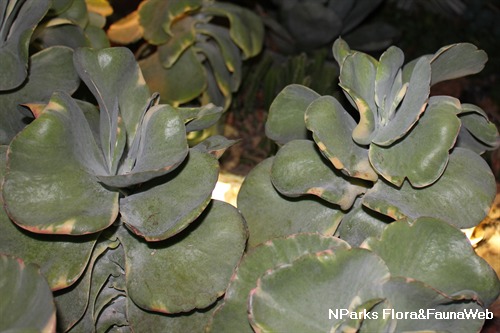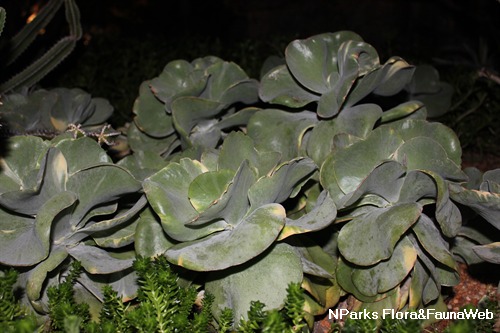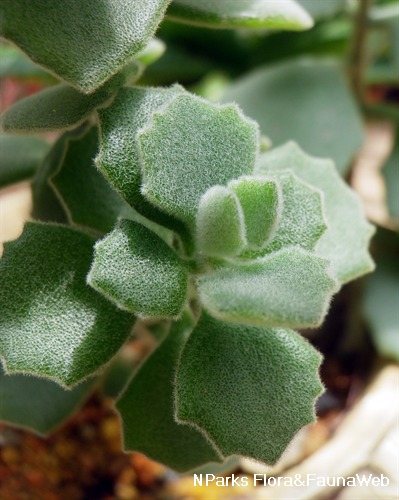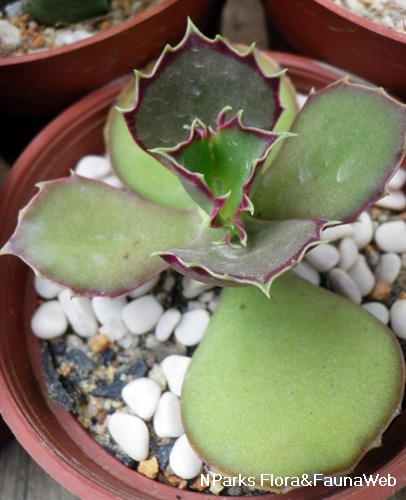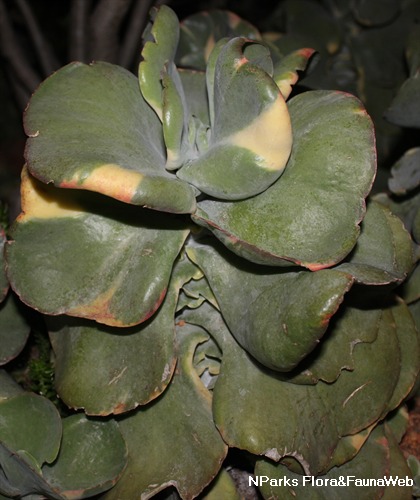
Back
Kalanchoe luciae 'Fantastic'
| Family Name: | Crassulaceae |
| Common Name: | Variegated Paddle Plant, Variegated Flapjack Plant |
Name
Classifications and Characteristics
| Plant Division | Angiosperms (Flowering Seed Plants) |
|---|---|
| Plant Growth Form | Shrub |
| Lifespan (in Singapore) | Perennial |
| Mode of Nutrition | Autotrophic |
| Plant Shape | Rounded |
| Maximum Height | 0.3 m to 0.6 m |
Biogeography
| Native Distribution | This cultivar is of horticultural origin and protected by US patent 21,945. It is often mistakenly referred to as Kalanchoe thyrsiflora 'Fantastic'. |
|---|---|
| Local Conservation Status | Non-native (Horticultural / Cultivated Only) |
Description and Ethnobotany
| Growth Form | Succulent up to 0.6 m tall. |
|---|---|
| Foliage | Smooth, fleshy, rounded to paddle-shaped leaves are greyish green with cream variegation and reddish tints near the leaf margin. In temperate countries, cool winter temperatures cause the reddish tint to become bright red. When grown under bright light, this cultivar forms compact rosettes. |
| Flowers | Pale yellow flowers have an urn-shaped, tubular base and 4 lanceolate lobes (lance-shaped with a wider base and pointed tip). They are arranged in dense clusters along a spike-like inflorescence. |
| Taxonomy | In the horticulture trade, this cultivar is often mis-labeled as Kalanchoe thyrsiflora 'Fantastic'. Kalanchoe luciae and K. thyrsiflora are similar, but the former has light yellow, non-fragrant flowers with urn-shaped tubes, while the latter has bright yellow, very fragrant flowers with cylindrical tubes. K. luciae leaves have bright red variegation when exposed to cool temperatures, while K. thrysiflora does not. |
| Cultivation | Although this cultivar has some drought tolerance, it grows best when the soil is watered thoroughly and then partially allowed to dry before re-watering. It prefers a well-drained potting mix rich in organic matter, such as half peat and half perlite. Avoid wetting the leaves to prevent disease. It will tolerate partial shade, but it will be more compact and produce more flowers under bright light, but protected from intense full sun. Pests include aphids, mealy bugs, scale insects and some caterpillars. Avoid using a pesticide that contains xylene. |
Landscaping Features
| Desirable Plant Features | Ornamental Foliage |
|---|---|
| Landscape Uses | Interiorscape/ Indoor Plant, Container Planting |
| Thematic Landscaping | Rockery / Desert Garden |
Plant Care and Propagation
| Light Preference | Full Sun |
|---|---|
| Water Preference | Moderate Water |
| Rootzone Tolerance | Well-Drained Soils, Fertile Loamy Soils |
| Maintenance Requirements | Low |
| Diseases | Powdery mildew, Phytophthora and Pythium (fungi that cause rot) |
| Pest(s) | Chewing Insects, Sucking Insects |
| Propagation Method | Stem Cutting |
Floral (Angiosperm)
| Flower & Plant Sexuality | Bisexual Flowers |
| Flower Colour(s) | Yellow / Golden |
|---|---|
| Flower Grouping | Cluster / Inflorescence |
| Flower Location | Terminal |
| Flower Symmetry | Radial |
| Individual Flower Shape | Urceolate / Urn-shaped |
| Flowering Habit | Polycarpic |
References
| References |
|---|
Image Repository
Others
| Master ID | 31856 |
|---|---|
| Species ID | 6256 |
| Flora Disclaimer | The information in this website has been compiled from reliable sources, such as reference works on medicinal plants. It is not a substitute for medical advice or treatment and NParks does not purport to provide any medical advice. Readers should always consult his/her physician before using or consuming a plant for medicinal purposes. |

